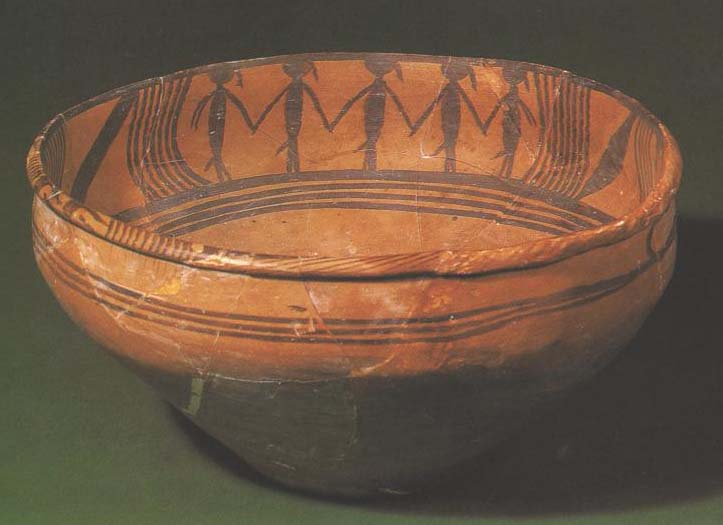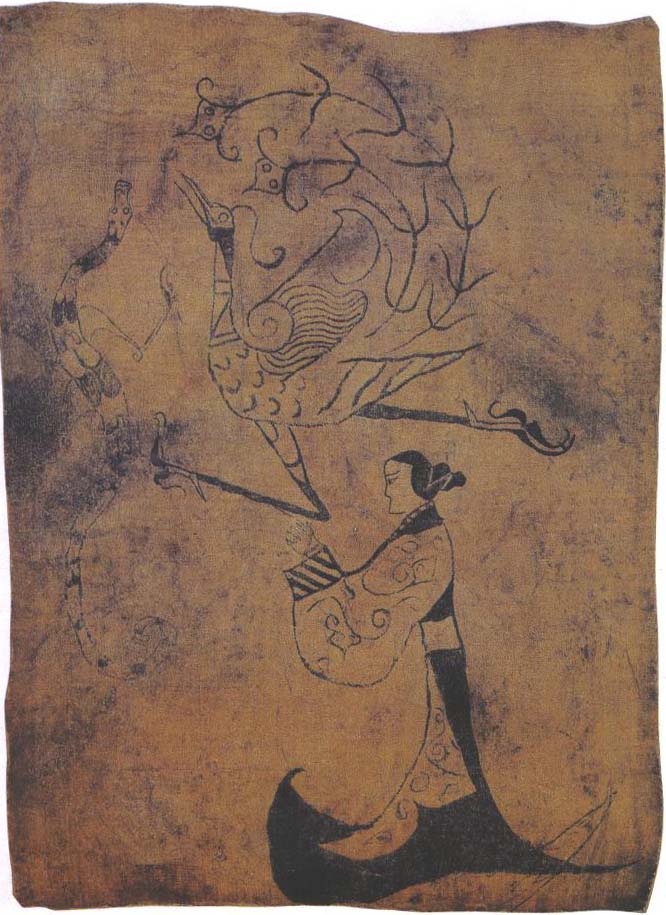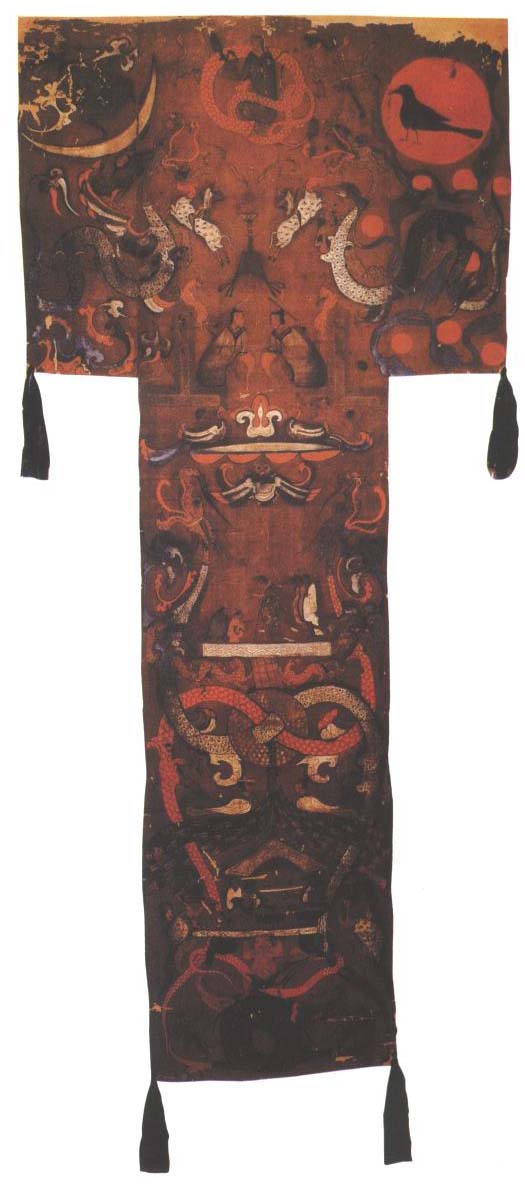|
| |

|

I.
The Primitive Society, Pre-Qin, Qin and Han Dynasties
The earliest form of painting is the rock painting of prehistoric hunting scenes which dates back about 3, 40 thousand years. The contents of rock paintings are closely related to witchcraft rituals and totems, reflecting the human activities at that time. In China, the well-known prehistoric rock art were found at Yinshan Mountain in Inner Mongolia Autonomous Region, Altai Mountain and Tianshan Mountain in Xinjiang Uygur Autonomous Region, Helan Mountain in Ningxia Hui Autonomous Region, Cangyuan in Yunnan Province, Zuojiang River Basin in Guangxi Zhuang Autonomous Region, Tibet, Xianzi Lake in Fujian Province, the General Cliff in Jiangsu Province, Wanshan Mountain in Taiwan, etc. In Neolithic Age (it can be roughly dated from about 10000 B.C. to 2000 B.C.), human beings began to rely on agriculture and animal husbandry to live a resident life. The development of hand tools and requirement of fixed settlement get people to start mass production of pottery. |
| Our ancestors smoothed the earthenware, painted patterns on them with ochre and oxidized manganese minerals, and then fired them to make them hard. After that the potteries appeared simple and harmonious patterns in red, black and white. Representative works of this period include: the Pottery Basin with Human Mask and Fish Pattern unearthed at Banpo Neolithic Village in Xi'an Province, the Dancing Pattern Pottery Basin unearthed at Datong County in Qinghai Province, and the Painted Pottery Jar with Stork, Fish and Axe Patterns unearthed at Yan Village, Linru County in Henan Province. |
 |
|
The Xia Dynasty which is thought to have run from the early 2100 B.C. is recorded in history books as the first slavery dynasty in China. About this dynasty there is no conclusive archaeological evidence so far, while the following dynasties, Shang Dynasty and Zhou Dynasty, did leave us treasures of civilization - bronze ware. Bronze ware could not emerge without a large amount of manpower and material resources invested in mining, refining, smelting, rafting and casting, which proves that in Shang Dynasty, there was sufficient resources and productive forces. By summarizing the predecessors' achievement, the magnificent bronze ware made in Shang Dynasty had formed a series of significance of decorative patterns, such as Tao-tie, thunder pattern, bird pattern, dragon pattern and scale pattern, etc.
During the Spring and Autumn period of the Zhou Dynasty, power of the King of Zhou was weakened, and there was a lot of rivalry and wars; during the Warring States period afterwards, feudal lords fought against each other, and the only law was the law of the jungle. Despite the chaos, from the stories recorded in ancient books, we can still see painting development in this period. The "Confucius" mentioned in the Mingtang (the hall of light, where the sacrifice rite was held and ruler met their feudal lords), there were portraits of ancient sages and tyrants, reminding the later rulers to learn lessons from their successes or failures. When Qu Yuan saw the mural paintings in the temple of deceased king of Chu and ancestral hall of the high-ranking officials, he had real feelings in those "heaven and earth, mountains and rivers, gods and spirits, all the great and unpredictable things, the ancient sages and monsters", thus he wrote his famous poem "Tian Wen" (the heaven's questions). Liu Xiang wrote a story in "Shuo Yuan" (a historical personage story collection): When Qi was building the ninth heavenly platform, painter Jing Jun missed his wife so much that he painted his wife's portrait on the wall to cure his lovesickness. |
|

|
One day, the king of Qi saw the beautiful portrait and was moved by it, and even took the woman from her husband at last. It can be taken as an evidence of painting's appeal at that time. Unearthed from Chu Tomb in Changsha, Hunan Province, paintings "Dragon and Phoenix Human Figure Painting on Silk" and "Driving Dragon Painting" present what the paintings were like during the Warring States Period. As the earliest two paintings found in China so far, these two silk paintings depict the appearance of the buried, and dragon and phoenix which guide his/her soul. The whole image was based on lines, which were smooth and forceful, and the style was solemn and elegant. From the day of birth, Chinese painting has already showed the characteristics of mainly using lines.
|
|
In 221 B.C., Emperor Qin Shihuang unified China. Qin became the first united multi-ethnic centralized feudal empire in Chinese history. Emperor Qin Shihuang liked the gorgeous palaces of the other six states, so whenever he destroyed a state, he would order painters to paint the palace, and then build a similar one in Qin's capital Xianyang. After he unified China, he started feverish constructions despite the widespread resentment among the people. He drove more than 700 thousands workers to build the Epang Palace and the mausoleum north of Lishan Mountain. In these large buildings which were to show off the great achievement of unification and the supreme authority of Qin Shihuang, there were many mural paintings. However, when these buildings disappeared gradually, the mural paintings have bitten the dust as well. In 1970s, some mural paintings were discovered in the site of Xianyang's First Palace. As the only surviving mural works of Qin Dynasty so far, these mural paintings possessed very high artistic attainments with a robust style. From the existing architecture site and the Terra Cotta Warriors, we can also figure out the majestic style of the paintings in Qin Dynasty.
The emperor of the Han Dynasty attached great importance to using fine arts to promote the prestige of the Han dynasty. Emperor Wu of Han (Liu Che) set up a large monumental sculpture in front of the tomb of general Huo Qubing, and portrayed the heroes since the founding of Han in the Kirin Court of Weiyang Palace. Emperor Ling of Han (Liu Hong) painted 32 scholars' portraits, including Hongdu Scholar Le Song and Jiang Lan, in order to encourage the other scholars. |
The feudal lords also built their palaces, in which the heaven and earth, mountains and rivers, gods and spirits were painted. For example, in the Emmanuel Temple built by the Lord Gong of Lu, a series of kaleidoscopic "all kinds of species, odd stuffs, mountains and rivers, gods and spirits" were depicted vividly. Even the local officials were no exception. The remained paintings of Han Dynasty are mainly tomb murals, stone carvings, brick carvings, silk paintings, board and wooden clip paintings, as well as lacquer paintings. With wide range of subject matters, a variety of forms of expression, and bold artistic techniques, these artworks show us the optimistic and cheerful side of the feudal times when the society was peaceful. Among them the simple but powerful, extensive and vigorous, and highly imaginative brick carving is the representative art form of Han Dynasty. In the meantime, the shaping skill and composition techniques of tomb murals were more complicated than previous dynasties, reflecting the burial custom of "burying one as one is still alive". The tomb murals of Helingeer County in Inner Mongolia Han province can be taken as an example.
Before the Han Dynasty, "moral education" was always the main ethical characteristics of painting. Just like the Ya (Festal Odes) and Song (Sacrificial Songs) in "the Book of Songs", painting needs to undertake the warning and education function.
|
 |
原始社会 先秦 秦汉
绘画最早的形态是史前时期以狩猎为对象的岩画,距今约3、4万年。岩画的内容与巫术礼仪和图腾活动有密切关系,反映了当时人类活动的场景。国内著名的史前岩画发现地有内蒙古阴山,新疆阿尔泰、天山,宁夏贺兰山,云南沧源,广西左江流域,西藏,福建仙字潭,江苏将军崖,台湾万山等。新石器时代(大约从1万年前开始,结束时间从距今5000多年至2000多年不等),人类开始依靠农业和畜牧业定居生活。手工工具的发展和定居生活的需要使人们开始大量制作陶器,先民们把陶坯打磨光滑,再用赭石和氧化锰等矿物质绘上图案,然后用火烧制成坚硬的陶器。烧制成型的彩陶呈现出赭红、黑、白诸种颜色图案,显得简单而和谐。陕西西安半坡遗址出土的人面鱼纹彩陶盆、青海大通县出土的舞蹈纹陶盆、河南临汝县阎村出土的鹳鱼石斧彩陶盆等是这一时期的代表作。
史书记载中国第一个奴隶制王朝是约在公元前二十一世纪初开始的夏朝,关于这个朝代至今并无确凿的考古证据,但随之而来的商朝和周朝却给我们留下了文明的瑰宝——青铜器。青铜器从采矿到冶炼到合金到铸造,无不需要投入大量的人力物力,它的出现,说明商代已经拥有充分的资源并且能自如地调动这些资源。商代制造的青铜器美轮美奂,它的纹饰经过前人的总结与概括,形成了模式化并具有典范意义的装饰纹样,如饕餮纹、雷纹、鸟纹、龙纹和鳞纹等。
春秋时期周王的势力减弱,群雄纷争,战国时期诸候混战,弱肉强食。尽管世事混乱,从古代典籍记载的故事里,我们仍然可以窥见这个时期的绘画状况。《孔子家语》中提到在祭祀与统治者会见诸侯的明堂中绘有古代圣贤与暴君之像,警醒后世统治者从他们的成败中汲取教训。屈原因见楚先王庙及公卿祠堂壁画中画有“天地山川神灵,琦玮谲诡,及古圣贤怪物行事”有所感悟,而书写了《天问》。刘向在《说苑》中记载:齐国造九重台,画工敬君怀念妻子,在壁上画妻子像,对之喜笑忘忧,可是齐王看到了美丽的画像,竟夺取了敬君的妻子,当时绘画的感染力由此可见一斑。出土于湖南长沙楚墓的《龙凤人物帛画》和《人物驭龙帛画》向我们直接呈现了战国时期的绘画面貌。这两幅帛画是我国至今发现最早的独立绘画门类作品,描绘了墓葬死者的仪容和引导死者灵魂的龙凤,整个画面以线条勾成,画风简朴流畅。国画从诞生伊始就具备了以线条为主的画法特点。
公元前221年,秦始皇嬴政统一中国,成为中国历史上第一个多民族的统一的中央集权制封建帝国。嬴政很喜欢六国华丽的宫殿,所以,每当灭掉一个国家,他都要让人将宫殿的图画下来,然后在咸阳照样仿造。统一中国后,他大兴土木,不顾民怨沸腾,运用劳工七十余万修建阿房宫和骊山陵墓。在这些为了宣扬秦始皇统一大业及其拥有的无上权威而建造的规模宏大的建筑群内部,绘制有许多壁画。随着建筑物的陆续消亡,这些壁画几乎丧失殆尽。二十世纪70年代发现的秦都咸阳第一宫殿遗址中有壁画遗迹,是仅存的先秦宫殿壁画作品,其风格雄健,艺术造诣相当高。从秦代的建筑遗物和兵马俑中也能推想出秦代绘画深沉雄伟的气魄风格。
汉代皇帝十分重视用美术来宣扬汉王朝的威信。汉武帝刘彻在大将军霍去病墓前竖立起大型纪念碑雕刻,在未央宫麒麟阁图绘建国以来的功臣。汉灵帝刘宏为鸿都文学乐松、江览等三十二人图像立赞,以劝学者。诸侯王也大肆建造宫室,在壁上图画天地、山海、神灵,鲁恭王建造的灵光殿就描画了千变万化的“品类群生,杂物奇怪,山海神灵”。连地方官吏也不例外。留存至今的汉代绘画主要有墓室壁画、画像石、画像砖、帛画、木板画、漆画等许多品种,它们的题材内容广泛,表现形式多样,艺术手法大胆,展现出封建社会和平进步时期乐观开朗、宽容大度的一面。其中,画像砖风格雄健拙朴,想象力无拘无束,是汉代艺术的代表形式。而墓室壁画的造型和构图比前朝更丰富复杂,充分体现出汉代“事死如事生”的厚葬风俗,其中以内蒙古和林格尔汉墓壁画为代表。
汉代以前,“成教化,助人伦”一直是绘画的主要伦理特征,就像诗经中的雅颂一样,绘画需要承担对人们的鉴戒和教育功能。 |
| |
|
|
|
|
|
|
|
|
Next
Page -> |
|